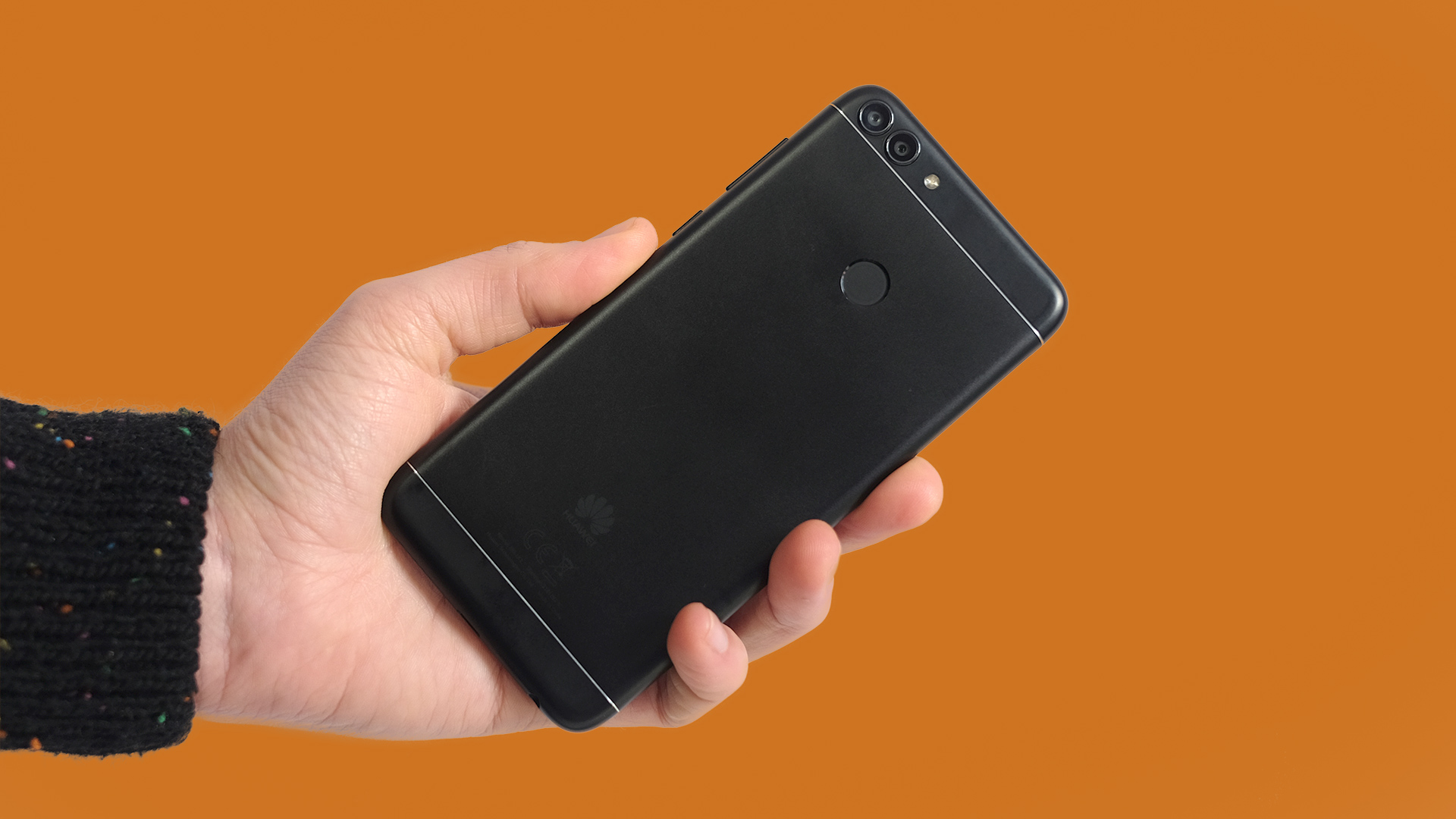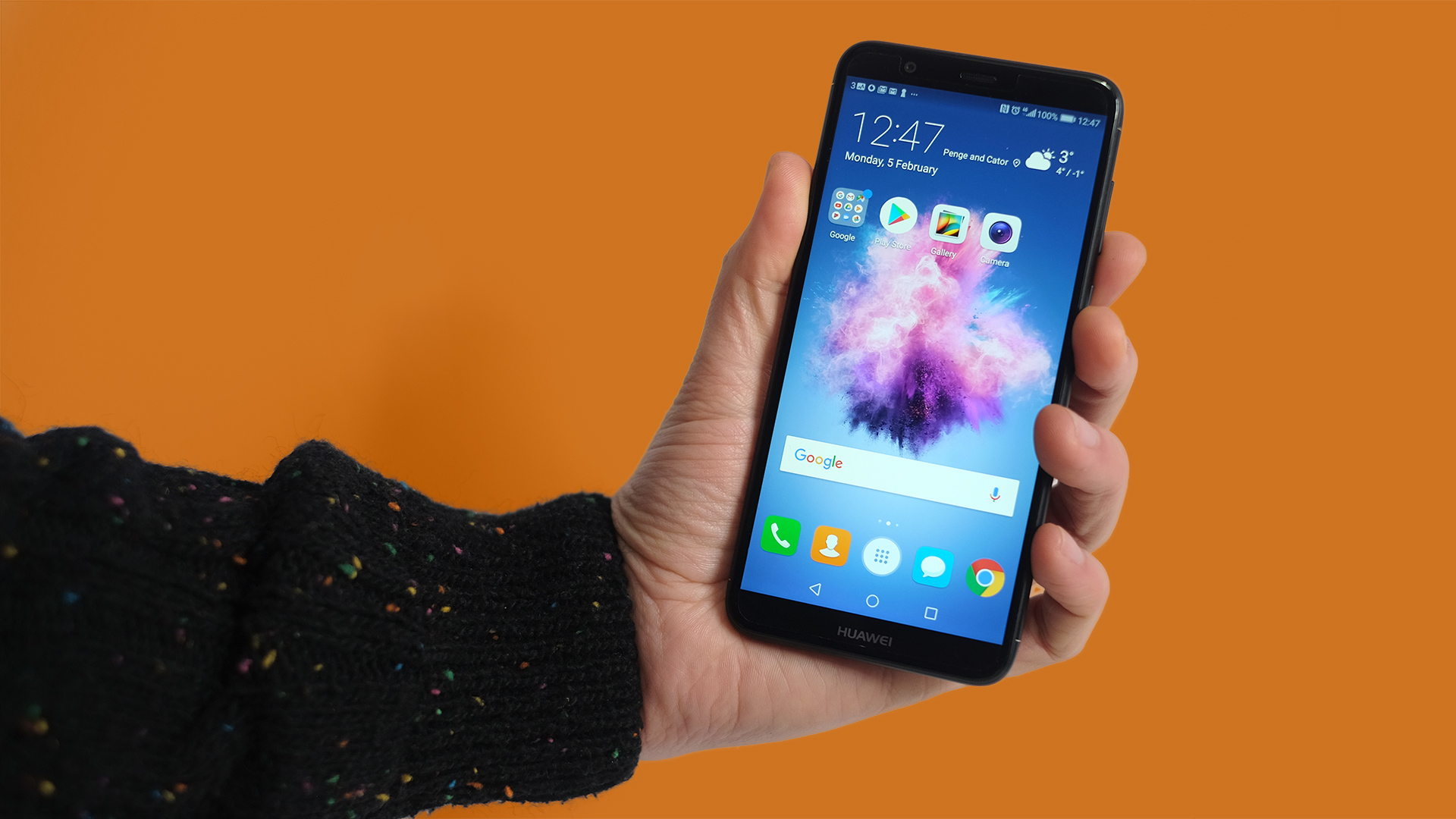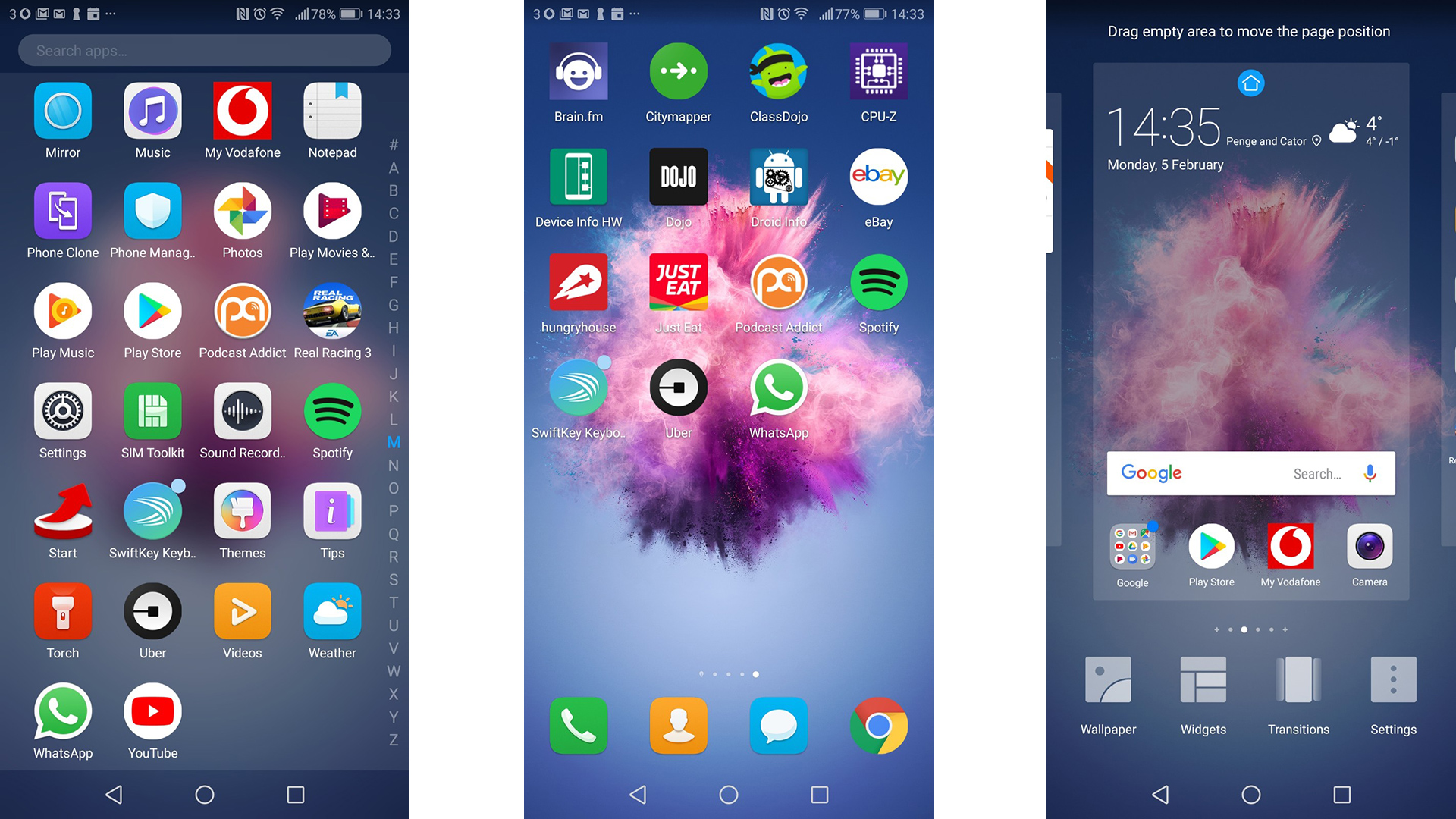Huawei P Smart
The Huawei P Smart is part of a wave of new phones that seem similar to those released six months earlier but have an ultra-wide (or long) screen.
It's also very similar to the Honor 9 Lite, but has an aluminium back instead of a glass one.
It doesn't have an ultra-high spec camera or a killer chipset, but is a quality phone sold at the right price. You'll save a lot of money over a 2-year contract with a Huawei P Smart.
Huawei P Smart price and availability
- Out now in the UK
- Temporarily a Vodafone exclusive
At the time of writing, Vodafone has a UK exclusive on the Huawei P Smart and it's not widely available in the US yet. Unusually, you can't buy it outright from Vodafone, just on a 2-year contract with a one-off charge of £9 and monthly fees from £17.
Compared to other Vodafone devices at the price, this makes the Huawei P Smart a killer deal. Competing picks are the Huawei P8 Lite and Vodafone Smart N8. The Huawei P Smart is better than either.
Looking wider, other alternatives include the Samsung Galaxy J5, a conspicuously lesser phone in some respects. The models we'd recommend considering too include the Moto G5S Plus and Honor 9 Lite.

Key features
- 18:9 screen
- A good design
The Huawei P Smart is a relatively low-cost phone, one that competes with models like the Moto G5S Plus and Honor 9 Lite.
Its most important feature is an 18:9 aspect ratio screen, which leaves less blank border above and below the display. You get more screen inch per inch of phone with this now-common design.
It also has a construction style that, like the Moto and Honor, isn't that easily distinguished from a more expensive phone.

The hardware inside is that of a low to mid-range device, though. It has an octa-core chipset without the blistering performance seen in more expensive rivals.
And while the Huawei P Smart has dual rear cameras, the 13MP and 2MP array won’t get you the image quality or level of background blur effect an iPhone X would.
However, almost every little compromise in the Huawei P Smart is easy to accept as long as you keep your expectations in line with the price.
Design
- Aluminium rear with plastic caps
- Low-surround design
- Slim at 7.5mm thick
The Huawei P Smart's job isn't to excite you like an iPhone X. It just needs to look and feel good enough to make spending 3-4 times the price seem silly.
Huawei has done a good job of dressing up what is at best a mid-range construction as something high-end. Let's deal with the back first.
The rectangle bordered by the two bright silvery strips is anodised aluminium. But above and below it, the end caps are plastic.

It's the kind of compromise you'll only notice if you go looking for it, but this makes the Honor P9 Lite a higher-end design than the Huawei P Smart. Its outer is all glass and aluminium.
The Huawei P Smart also has a mix of up-to-date and older hardware features. There's a very good fingerprint scanner on the back. It's significantly recessed, so you can't miss it, and works quickly.
However, the Huawei P Smart also has a micro USB charge socket rather than a USB-C. While the main real-world benefits are simply being able to plug it in either way around, and support for future USB accessories like headphones, it does seem dated at this point.

There's a headphone jack too, which some of you may well have traded a USB-C away for anyway.
The Huawei P Smart is not water resistant and doesn't trim down the screen surround as much as some recent, more expensive phones. But it's otherwise very easy to live with. The phone is narrower than a Moto G5S and is easy to handle. At 7.5mm thick it's also slim.

Screen
- Trendy 18:9 aspect ratio
- 1080 x 2160 resolution
- IPS LCD panel
Very wide aspect screen phones like this make you reconsider what a 'big' screen size really is. The Huawei P Smart has a 5.65-inch screen but in handling terms the phone is similar to one with a 16:9 5.2-inch screen.
Its screen uses an IPS LCD panel with a resolution of 1080 x 2160, the same as just about all lower-cost 18:9 aspect phones. Color, contrast, sharpness and brightness are solid. For some reason a couple of apps seem to run at 720p, but that's the software's fault, not the screen.
Ultra-deep color is what you miss compared with a more expensive phone. Tones look fairly natural and well-saturated, but comparing the Huawei P Smart with the 'DCI P3' cinema mode of the recently reviewed HTC U11 Plus, the more expensive HTC's screen is richer still.
You can't fiddle with the Huawei P Smart's saturation or contrast, but there is a color temperature control. Different eyes will prefer different tweaks. We quite like the phone with a slight warm skew.
Battery life
- 3,000mAh battery lasts a day but won't stretch to two
- No fast charging
The Huawei P Smart has a 3,000mAh battery, which is a good capacity for a phone of Full HD+ resolution. In our experience the phone lasts a full day without issue, including a few hours of podcast streaming, some web browsing and many WhatsApp checks.
However, it doesn't quite reach the heights of Huawei's top performers like the Huawei Mate 10 and Huawei P10 Plus. While we found we usually had some juice left to take us into mid-morning on day two, the Huawei P Smart is not a phone we could get to last a full two days of normal use.
Playing back a 90-minute 720p video at maximum brightness takes 22% off the charge level, which is not bad but worse than the Moto G5S. That lost just 16%.
It also lacks true fast charging. 'Turbo' chargers either use higher-than-normal voltage or current to replenish a phone's battery very quickly but the Huawei P Smart's just uses the standard 5V, 2A plug.
More expensive Huawei's use the company's SuperCharger, which provides over double the power transfer rate.
Camera
- Poor low-light performance
- Background blur on both cameras
- Decent daylight image quality
The Huawei P Smart has two cameras on its rear. Huawei has made more dual camera devices than just about any other manufacturer, but this is one of its lower-end setups.
There's a 13MP main sensor and a low-resolution 2MP one to provide depth information. Some dual camera arrays are used to improve image quality, add zoom or even a wide-angle view. The Huawei P Smart's is just for wide aperture shooting, letting you blur out the background or foreground for a dramatic effect.
Using a low-res depth sensor means the unseen 3D map the Huawei P Smart makes of a scene is rudimentary. As a result, edges tend to get confused and you end up with odd-looking photos unless your subject is reasonably close, simple and is well-separated from the background.
We can't fault the phone for trying, though, as it'll apply pretty dramatic blur to almost any scene. It just won't always do it that well.
The Huawei P Smart also lacks the artificial intelligence scene processing of some high-end phones. However, it does have a good stab at managing scenes with tricky brightness levels, applying post-processing to make each look right.
Your day-lit photos will look great on the Huawei P Smart's own screen. Opening them up on our color-calibrated monitor, though, it's clear the phone only has entry-level hardware. Fine details look vaguer than they would seen through a high-quality 12MP phone camera and dynamic range is just okay.

The Huawei P Smart does not handle night shooting well. It's slow to take photos, dark scenes will often appear severely underexposed, and when they are not they'll either look very soft or noisy.
At the price the Huawei P Smart's camera is fine, but it does not set any new standards.
Phones like the Honor 9 and OnePlus 5T have much better cameras, a reason some may want to spend more.
As in other Huawei phones, there are many extra modes. These include HDR, time lapse, light painting and a pro mode that gives you control over parameters like shutter speed, ISO and exposure. You'd need to use a tripod to get the best out of the latter, though, as there's no stabilization to let you slow down the shutter without ending up with blurred shots.
Around the front, the Huawei P Smart has a single 8MP selfie camera. It's a good one too, producing natural-looking skin tones and good detail with reasonable lighting.
There's also a selfie background blur mode that uses software smarts rather than a second camera. As with the rear blur effect, the outlines aren't always perfect, but are usually sound enough.
Camera samples
Interface and reliability
- Android 8.0
- EMUI 8.0
- Some performance issues
The Huawei P Smart runs Android 8.0 with Huawei's EMUI version 8.0. It's all eights.
Whenever we start reviewing a phone with EMUI, we tend to head straight to the settings to change the home screen style. As standard EMUI leaves out the apps menu, for a more iPhone-like home screen-based experience.
You can reinstate it, though. This turns the Huawei P Smart from a phone with slightly strange software to a much more normal-feeling interface with almost zero learning curve.

The look is fairly inoffensive, although parts of Huawei's characteristic style remain. A 'Magazine' lock screen flashes up stock-style images when the phone is brought out of standby, and the setting menu looks different to Android's norm.
The Huawei P Smart's interface can be changed further with themes. These can get rid of the custom lock screen if you like, and alter icons and wallpapers. We tried one called Project Y with this phone for a few days.
It looks just about as good as the default one, and if you’re after a theme with a cartoony or unusual look, there are plenty to choose from.

EMUI isn't slow. The Huawei P Smart has no phone-ruining performance problems. However, in switching from the HTC U11 Plus to this phone we did notice the occasional moment of lag as the keyboard caught up with our input. Or, more rarely, when dragging down the notification bar.
This doesn't occur regularly as you type addresses into Chrome or messages into WhatsApp, though.
Performance is close enough to higher-end phones to avoid annoyance, but we noticed fewer of these blips in the Moto G5S Plus.
Movies, music and gaming
- Solid but not perfect gaming performance
- Widescreen aspect great for games and movies
- Slightly thin-sounding speaker
The GPU, the piece of hardware that handles graphics processing, is one of the Huawei P Smart's weaker parts. It uses a dual-core Mali-T830 chip, which is less powerful than the Adreno 506 of the Moto G5S Plus.
In high-end games like Asphalt 8, those keen on high frame rates will notice drops in the scrolling scenery. However, we're talking about slight dips into, say, 20-25fps rather than teen figures that really impact play.
The 18:9 screen aspect is also handy for console-style games like Dead Trigger 2 and Asphalt 8. It leaves more room for the virtual controls.

The Huawei P Smart’s audio shows clearer compromise. There's one speaker on the bottom, and it's relatively thin-sounding. The last couple of years have seen phones get by with a single driver just fine, providing enough bulk to the lower frequencies to add a touch of richness. This one is just okay.
There are no extra apps for audio or video either, beyond an FM radio most will ignore and a simple Dictaphone-style audio recorder app.
We'd rather have this approach than a phone weighed down by bloat software, though, and there are plenty of media players you can download for free from Google Play.
Performance and benchmarks
- Huawei-made octa-core CPU
- Raw performance in line with the price
Looking a little deeper into the Huawei P Smart's hardware, it has a HiSilicon Kirin 659 chipset. This is made by a Huawei subsidiary. Other mid-range phones tend to use either Qualcomm or MediaTek CPUs.
Aside from the weaker GPU, performance is roughly comparable with popular chipsets like the Snapdragon 625 and 630. There are eight Cortex-A53 cores in two clusters, with four clocked at 2.36GHz and the other four running at 1.7GHz.
The Huawei P Smart scores 3,734 points in Geekbench 4, which again is similar to phones in the same class with Snapdragon CPUs.
This is a 'powerful enough' phone rather than a spec monster, but the slight system lag and just okay gaming performance wouldn't put us off recommending this phone to most people.
It has 3GB of RAM, now the standard amount for this level of phone. And 32GB of storage, which leaves you enough room to install a lot of apps and games. There’s also a microSD card slot if you need more room.
Verdict
The Huawei P Smart is a good way to get an ultra-wide 18:9 screen phone at a sensible price, particularly as the budget Moto range is still stuck with 16:9 displays.
There are the usual compromises with camera quality and raw power at this price, and the P Smart is not quite the best day-to-day performer in its class.
However, we didn't find anything that should put too many people off if you find it offered as part of an attractive contract deal.

Who's this for?
The Huawei P Smart is for people who want a phone on an affordable contract, but still want a modern design and a metal build rather than a basic plastic mobile.
Should you buy it?
Find the right deal for the Huawei P Smart and there are few reasons to delay, as long as the occasional stutter isn't going to annoy you.
You can potentially save even more with a Moto G5S, but it has a less up-to-date design and only a single-lens camera.
Want some alternative options? Consider the following three phones.
Honor 9 Lite

The Honor 9 Lite is the Huawei P Smart’s cousin. They share a lot of the same components, but the Honor has a glass back instead of an aluminium one. And a higher-end selfie camera. So, do you want glass or aluminium?
- Read the full Honor 9 Lite review
Moto G5S

It’s a little older, a little fatter and has a 16:9 screen rather than an 18:9 one. However, we still have a lot of affection for this aluminium budget phone, and we prefer its camera. It can’t pull off the background blur tricks of the P Smart, but does produce better day-lit shots.
- Read the full Moto G5S review
Samsung Galaxy J5

Samsung’s cheapest phone we wouldn’t mind using day-to-day is the Galaxy J5. It has an aluminium shell, a decent 13MP camera and an Exynos CPU of roughly the same power (if an even weaker GPU).
Its display is OLED rather than LCD, but is also of much lower resolution, 720p, and doesn’t have the Huawei’s wide aspect ratio.
First reviewed: February 2018
0 comments:
Post a Comment